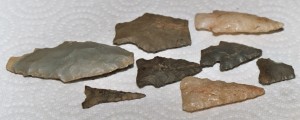In my Forest Management Plan, it states:
“No cultural, archaeological, or historical sites are located on the property. If any sites or artifacts are discovered, please notify the Illinois State Historic Office.”
On first reading, this seemed clear. But as I thought more about it, I wasn’t too sure exactly what an “artifact” was. Sure, I had a general sense of it, but my father-in-law (a retired farmer) told me that he would turn up old stone arrowheads when plowing or cultivating his fields, several times a year.

I hadn’t found any arrowheads in my forest, but in the event I did stumble over something, I wanted to make sure I wasn’t doing anything wrong by not reporting it, or by overreacting if I did report it. In my distant genealogical past, I have some Cherokee blood (my great-great-great, great-great-great Grandma was Cherokee), and I wanted to be respectful but not crazy. I decided to call the Illinois State Historic Office for guidance.
The office was open and my call was taken right away. The man answering my call was pleasant, but noticeably wary. It was as though he were looking for hidden meanings or agendas in every question I asked. I began by explaining about having recently inherited a forest, and the clause in my Forest Management Plan that discussed artifacts.
“What exactly is an artifact?” I asked.
“What have you found?”
“I haven’t found anything yet, but in the event that I find something, I want to know whether I should report it or not.”
“If you find an old Native American village, with a bunch of pottery, old graves and bones, then you need to stop whatever you’re doing and report it right away.”
“Yes, thank you. I understand that, but that’s not why I’m calling.”
“So what have you found?”
“I haven’t found anything yet, and I’m not going looking for things. But I wanted to know if I should report finding an arrowhead to you.”
“A bunch of arrowheads and flint axes could be an old chipping station, and that would be pretty close to an old village and the burial grounds wouldn’t be far away.”
“Yes, I appreciate that, but I’m not asking about a bunch of arrowheads, axes, an old village and burial grounds…I’m just asking about a single arrowhead. If I were to find a single arrowhead, should I report that to you?”
“Is there any evidence of an old village or burial grounds nearby?”
“Not according to my Professional Forester, who wrote up my Forestry Management Plan.”
“How carefully did he look for evidence of an old village? Does he even know what to look for? He’s a Forester. Does he have any training in Native American artifacts and sites? Have you had an official archeological survey done?”
“No, I haven’t had an archeological survey done, and have no reason for doing one. I’m just working off this Forest Management Plan and trying to find out what my responsibilities are, should I stumble across an old arrowhead.”
“If you’re going to go digging around an old Native American site, you should have an archeological survey done first.”
“I’m not planning on doing any digging around, and my Forester tells me there are no sites. I just want to know whether you want to be notified if I happen to discover a single arrowhead…yes or no.”
In the end, he never did answer my question about the single arrowhead. I decided not to have an archeological survey done. If I find an old village, chipping station, burial ground and pottery, I intend to report that. If I find a single arrowhead, I’ll decide then whether it looks like an artifact or not.
